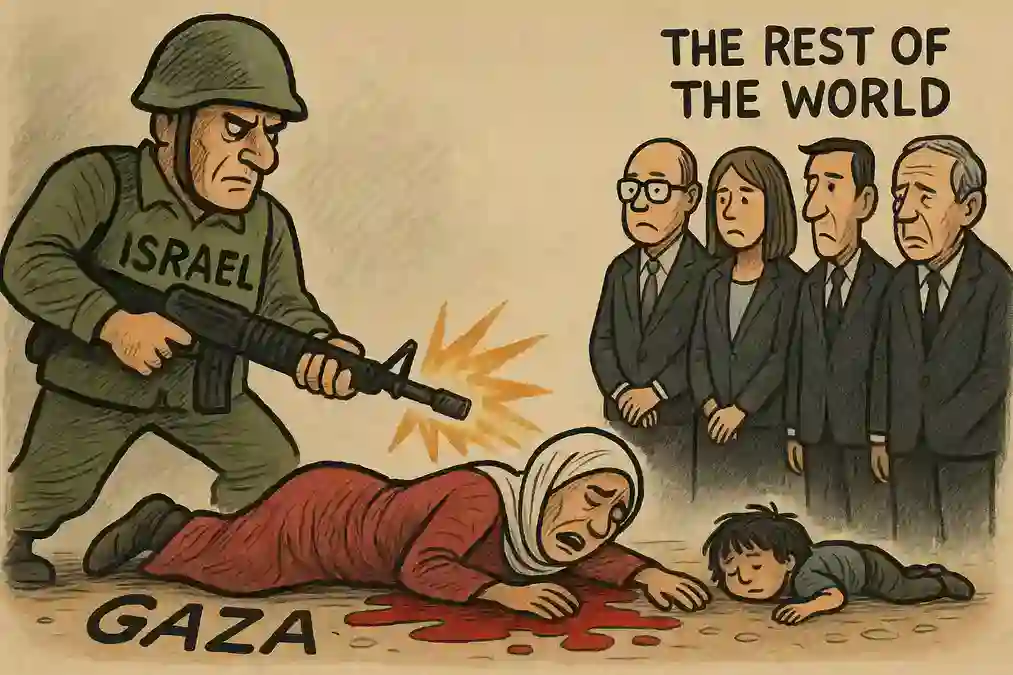The people of Gaza are living a nightmare that doesn’t seem to have a morning after. As of late June 2025, the death toll has crossed an unimaginable 56,000 lives—a staggering number that doesn’t just represent bodies, but families torn apart, neighborhoods flattened, and a generation of children who may never understand what peace feels like.
It’s been over a year and a half since the war reignited, and somehow, it keeps getting worse.
The Blood and the Bread
In Gaza today, even hunger is dangerous.
There have been dozens—sometimes hundreds—of desperate civilians gunned down while simply lining up for aid. Food trucks, instead of bringing hope, have turned into magnets for violence. Humanitarian corridors, once promised as lifelines, now feel like traps. In recent days, reports have surfaced of Israeli soldiers opening fire on crowds around aid convoys, allegedly under direct orders. Whether that’s true or not, the outcome is chilling: bodies strewn across dirt roads, holding nothing but empty plastic bags.
People now say: “You may die getting food, or die waiting for it. But either way, death’s the only constant.”
Hamas: Bruised, Not Broken
Hamas is a shadow of what it once was. Its vast tunnel networks—some the size of highways—are now rubble. Nearly 20,000 fighters have been killed, many high-ranking commanders among them. The Israeli military has managed to punch a hole straight through the group’s stronghold in northern and southern Gaza.
But here’s the twist: Hamas hasn’t disappeared. It’s gone underground—again. Still coordinating, still launching sporadic attacks, and still trying to maintain grip over the war-torn strip.
A growing number of local clans in Gaza, especially in the south near Rafah, are challenging Hamas’s authority. Some are angry. Others are just desperate. When Hamas tried to collect taxes or recruit fighters from these areas, the backlash was open and violent. One clan even told them to “go fight your own war,” a sentence that would’ve been unthinkable just a year ago.
Even Hamas’s backers, like Iran and Qatar, seem hesitant now—tired of the endless bloodshed, uncertain of Hamas’s long-term viability. But in Gaza, desperation often fuels defiance. And Hamas knows how to survive in the shadows.
Israel: No Ceasefire Without Disarmament
On the other side, Israel remains firm: there will be no permanent ceasefire until Hamas is completely disarmed.
Prime Minister Netanyahu is under enormous pressure. Hostage families in Israel are pleading for a deal, any deal, to bring their loved ones home. Many have held protests outside the Knesset. And yet, the Prime Minister is locked into a tight political corner, surrounded by far-right allies who refuse to back down until Hamas is obliterated.
The Israeli military has declared victory in many key zones—but Gaza is not just a battlefield. It’s a densely packed home for over 2 million people. Every airstrike, every ground operation, risks civilian casualties. And that toll is mounting.
Netanyahu’s administration is also now facing internal investigations after leaked reports alleged that soldiers were ordered to fire on unarmed Palestinians near food lines. If proven true, this could spark one of the biggest military scandals in Israeli history.
Yet the war grinds on. And the Israeli stance remains: “Security first, ceasefire later.”
Is a Ceasefire Even Possible?
In recent weeks, whispers of a potential ceasefire have grown louder. Negotiators from the U.S., Egypt, and Qatar have been working around the clock to get both sides to agree.
Hamas claims it never rejected the latest U.S.-backed plan outright. Instead, they requested modifications—mainly asking for a full Israeli withdrawal from Gaza and a long-term end to hostilities, not just a short-term pause.
Israel, in turn, insists that any deal must include the return of all hostages, the dismantling of Hamas’s armed wing, and strict international oversight of Gaza’s reconstruction.
So far, both sides are talking. But they’re still speaking two very different languages.
The Human Toll Is the Real Crisis
Behind all the headlines, behind all the numbers, are people—mothers cradling babies who no longer cry, fathers digging through rubble for family members, children with eyes too old for their age.
Hospitals are barely functioning. Medicines are running out. Clean water is a luxury. Schools are gone. The idea of a normal life is not even a fantasy anymore—it’s forgotten altogether.
Gaza is not just bleeding; it’s starving, crumbling, suffocating.
And around the world, millions are watching through screens—some in outrage, some in prayer, and many in numb silence.
America and the Global Balancing Act
The U.S. is caught in a moral and political balancing act.
On one hand, it remains one of Israel’s closest allies. On the other, it’s facing international criticism over the U.S.-supported aid delivery mechanism in Gaza, which many say is unsafe and ineffective.
President Trump, now campaigning heavily for reelection, claimed in a recent speech that a ceasefire is “very possible within a week.” But few believe it’ll be that easy. There’s simply too much distrust, too much damage, and too much pride at play.
What Happens Next?
Honestly, no one knows.
Some say Hamas is so weakened that Gaza may be governed by a new coalition—possibly under Arab League supervision. Others fear this war is just one chapter in a much longer, even darker story.
Peace isn’t impossible. But right now, it feels like a distant dream.
What’s clear is that this isn’t just a political conflict—it’s a human one. And while governments argue, people continue to die.
Children continue to lose limbs. Women give birth in tents with no electricity. Fathers carry their dead kids through rubble, still calling their names.
The Real Question
It’s not “who’s winning?”
The real question is: How many more have to lose?
Because at this point, Gaza isn’t a warzone—it’s a graveyard. And unless something changes soon, it’s going to bury a lot more than just bodies. It will bury hope. It will bury justice. And maybe even humanity itself.
Also read: Ceasefire Talks Begin After Fierce Blows From Both Iran and Israel

